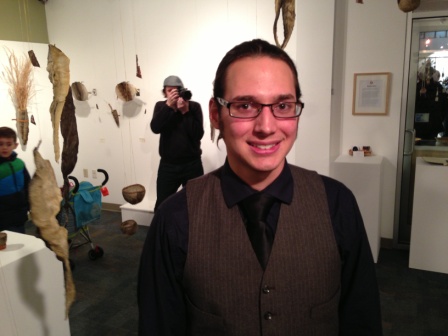
Joel Isaak started taking art seriously when he was in junior high school in his hometown of Soldotna, Alaska. Back then, it was ceramics that inspired his creative expression and helped set his course that led to the fine arts program at the University of Alaska, Fairbanks. An exploration of his Native heritage and complex family background would further mold, not only his artistic expression, but his desire to use his art as a positive influence on people’s lives.
Isaak’s family tree is a braided web with branches stemming from the Kenaitze Indian Tribe on the Kenai Peninsula, intermingling with German ancestry. Taking a break from his art studies, Isaak traveled to Israel to research Holocaust imagery and visited the Holocaust Museum. While there, he learned his German ancestors were Jewish.
“At the time, I was intrigued with how Nazi Germany was able to influence the masses through their propaganda,” Isaak said. “The purpose of the propaganda was malicious and immoral, and it motivated me to use my art to do the opposite – to be a positive influence.”
Isaak had also researched his Native heritage and was particularly impacted by the story of his grandmother, Feodoria Kallander Pennington. Pennington, originally from Point Possession, was evacuated to Anchorage where she attended a boarding school, Isaak said.
“She told me about the struggles she faced which were similar to what many Alaska Native people endured,” he said. “They were not allowed to speak their language. It was basically an attempt to force assimilation into the western culture.”
With the knowledge of his family background as a motivation and using traditional Dena’ina materials such as roots, bark and skins, the 24-year-old’s artistic expression evolved. That evolution went on display in February at an exhibit hosted by the Alaska Native Arts Foundation in Anchorage. More than 250 people attended the First Friday event to see Isaak’s unique art form – hanging salmon skins molded with facial impressions, a moose hide brought to life with the silhouette of a Native man and traditional drums made from dried fish skin.
“The purpose of my art is to communicate and create an open dialogue,” Isaak said. “Art has the ability to open up topics that are difficult to discuss. And, healing can’t happen until people can talk about issues.”
Isaak is a direct CIRI descendent through his mother, Sharon Isaak. With funding support from The CIRI Foundation, Isaak achieved his bachelor’s of fine arts degree from UAF in the fall of 2011. He was recently awarded a student fellowship to the Eiteljorg Museum of American Indian and Western Art in Indianapolis, Ind. where he participated in discussions about stereotypes and other issues facing Native American artists.
Isaak has his future sights set on obtaining a master’s degree in fine arts and he continues to pursue his artistic endeavors, combining originality with traditional Native culture to open new dialogue and communication. To learn more about Isaak and see a compilation of his work, please visit joelisaak.com.



